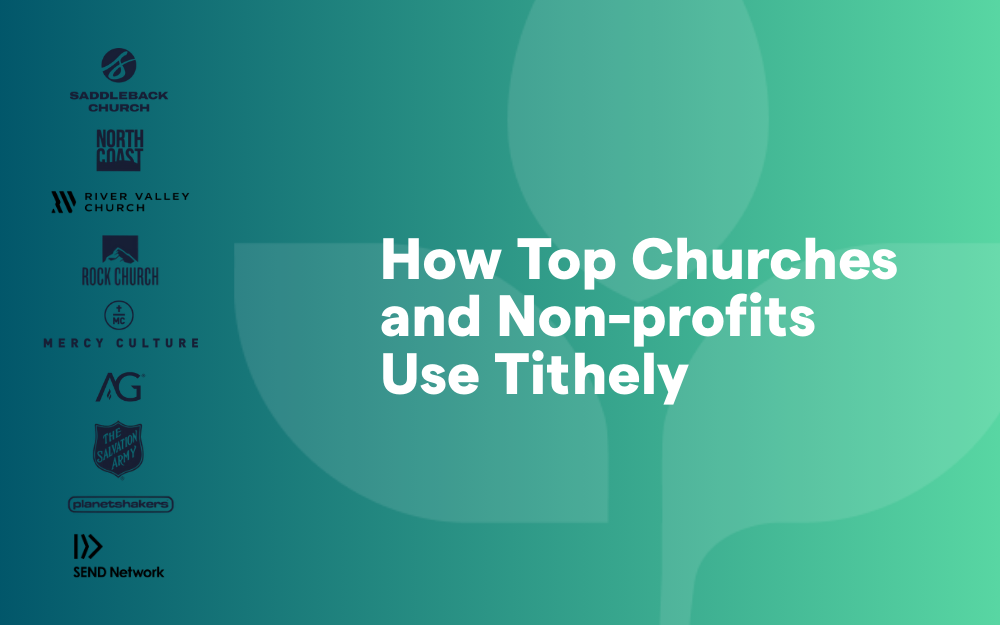Crafting a Customized Year-End Giving Strategy
Creating a customized strategy for your year-end giving campaign enables you to address the unique needs and behaviors of your congregation. It also paves the way for a more interactive, engaging, and successful giving season.

In a previous post, you learned how to set SMART goals to help you reach your year-end giving objectives.
The next step is to develop a strategy that makes those goals a reality. This post will guide you through the process of crafting a customized strategy tailored to your church's unique needs.
Components of a Comprehensive Strategy
Personalized Donor Communication Plans:
Segmented Mailing Lists: Categorize your donors based on their giving history, involvement in church activities, or demographic information. For instance, you might have lists for first-time donors, consistent tithers, youth members, or families.
Personalized Messaging: Tailor your communication to resonate with each segment. For example, thank first-time donors for taking the step to support the church, or remind long-time members of the cumulative impact of their consistent giving.
Targeted Calls-to-Action: Different donors might be motivated by different needs. While some might be inspired to support youth programs, others might be more inclined to contribute to community outreach. Ensure your calls-to-action align with the interests of each segment.
Targeted Campaigns:
Building Fund: If there's a need for infrastructure development, present a clear vision of what the new facility will look like and its benefits. Use visuals like architectural drawings or 3D renderings to inspire donors.
Missions Drive: Share testimonies from previous missions or stories from communities that have been impacted. Highlight the specific needs of the mission field and how the church plans to address them.
Donor Appreciation Events:
Thanksgiving Dinners: Organize a special dinner for donors, celebrating the year's achievements and sharing the vision for the upcoming year.
Recognition Ceremonies: Host an event where you acknowledge and appreciate significant contributors. This can be done with certificates, plaques, or simple tokens of appreciation.
Testimonial Sessions: Allow beneficiaries of the church's programs to share their stories. This can be a powerful way to show donors the direct impact of their contributions.
Innovative Engagement Tactics:
Text-to-Give: In today's digital age, many find it convenient to donate via text. Set up an online giving system where members can easily contribute using their mobile phones.
QR Codes: Place QR codes in strategic locations, like the church bulletin, pews, or entrance. Scanning the code can lead donors directly to the donation page.
Social Media Challenges: Leverage the power of social media by creating giving challenges. For instance, a "Give $20 Challenge" where members can donate $20 and then nominate others to do the same. This can create a ripple effect and increase participation.
Crafting the Strategy
Understanding the core components of a year-end giving campaign is just the beginning. The next step is to weave these components into a cohesive, actionable strategy. Here's how you can go about it:
#1: Build and develop a team.
Assemble a Diverse Team: Bring together a mix of church leaders, finance experts, marketing and communication professionals, and enthusiastic volunteers. Each person will bring a unique perspective and skill set to the table.
Brainstorming Sessions: Organize sessions where team members can share ideas, voice concerns, and propose solutions. Use tools like whiteboards, sticky notes, or digital platforms to visualize and organize thoughts.
Delegate Responsibilities: Assign specific tasks to team members based on their expertise. For instance, a communications expert might handle messaging, while a tech-savvy volunteer could manage the online donation platform.
#2: Allocate your resources.
Budgeting: Determine the financial resources available for the campaign. This includes funds for promotional materials, events, and any technological tools you might need.
Human Resources: Identify the number of volunteers or staff required for various tasks, such as manning donation booths, handling inquiries, or managing social media.
#3: Set timelines and milestones.
Campaign Calendar: Create a detailed calendar highlighting the start date, end date, and all the key activities in between. This will serve as a roadmap for the campaign.
Milestone Tracking: Set specific milestones, such as reaching 25%, 50%, or 75% of the fundraising goal. Celebrating these milestones can boost morale and maintain momentum.
#4: Stay flexible.
Feedback Loops: Establish mechanisms to gather feedback from the congregation and the broader community. This could be through suggestion boxes, online surveys, or informal conversations.
Performance Metrics: Regularly review metrics like donation amounts, donor demographics, and engagement rates. If something isn't working as expected, identify the reasons and adjust accordingly.
Adaptive Planning: While it's essential to have a plan, it's equally crucial to be adaptable. If unforeseen challenges arise, such as a sudden change in community needs or a global event impacting giving, be prepared to pivot your strategy.
Over to You
Creating a customized strategy for your year-end giving campaign enables you to address the unique needs and behaviors of your congregation. It also paves the way for a more interactive, engaging, and successful giving season. Stay tuned for our next blog post, where we'll delve into the vital topic of segmenting your giver base.
Sign Up for Product Updates
In a previous post, you learned how to set SMART goals to help you reach your year-end giving objectives.
The next step is to develop a strategy that makes those goals a reality. This post will guide you through the process of crafting a customized strategy tailored to your church's unique needs.
Components of a Comprehensive Strategy
Personalized Donor Communication Plans:
Segmented Mailing Lists: Categorize your donors based on their giving history, involvement in church activities, or demographic information. For instance, you might have lists for first-time donors, consistent tithers, youth members, or families.
Personalized Messaging: Tailor your communication to resonate with each segment. For example, thank first-time donors for taking the step to support the church, or remind long-time members of the cumulative impact of their consistent giving.
Targeted Calls-to-Action: Different donors might be motivated by different needs. While some might be inspired to support youth programs, others might be more inclined to contribute to community outreach. Ensure your calls-to-action align with the interests of each segment.
Targeted Campaigns:
Building Fund: If there's a need for infrastructure development, present a clear vision of what the new facility will look like and its benefits. Use visuals like architectural drawings or 3D renderings to inspire donors.
Missions Drive: Share testimonies from previous missions or stories from communities that have been impacted. Highlight the specific needs of the mission field and how the church plans to address them.
Donor Appreciation Events:
Thanksgiving Dinners: Organize a special dinner for donors, celebrating the year's achievements and sharing the vision for the upcoming year.
Recognition Ceremonies: Host an event where you acknowledge and appreciate significant contributors. This can be done with certificates, plaques, or simple tokens of appreciation.
Testimonial Sessions: Allow beneficiaries of the church's programs to share their stories. This can be a powerful way to show donors the direct impact of their contributions.
Innovative Engagement Tactics:
Text-to-Give: In today's digital age, many find it convenient to donate via text. Set up an online giving system where members can easily contribute using their mobile phones.
QR Codes: Place QR codes in strategic locations, like the church bulletin, pews, or entrance. Scanning the code can lead donors directly to the donation page.
Social Media Challenges: Leverage the power of social media by creating giving challenges. For instance, a "Give $20 Challenge" where members can donate $20 and then nominate others to do the same. This can create a ripple effect and increase participation.
Crafting the Strategy
Understanding the core components of a year-end giving campaign is just the beginning. The next step is to weave these components into a cohesive, actionable strategy. Here's how you can go about it:
#1: Build and develop a team.
Assemble a Diverse Team: Bring together a mix of church leaders, finance experts, marketing and communication professionals, and enthusiastic volunteers. Each person will bring a unique perspective and skill set to the table.
Brainstorming Sessions: Organize sessions where team members can share ideas, voice concerns, and propose solutions. Use tools like whiteboards, sticky notes, or digital platforms to visualize and organize thoughts.
Delegate Responsibilities: Assign specific tasks to team members based on their expertise. For instance, a communications expert might handle messaging, while a tech-savvy volunteer could manage the online donation platform.
#2: Allocate your resources.
Budgeting: Determine the financial resources available for the campaign. This includes funds for promotional materials, events, and any technological tools you might need.
Human Resources: Identify the number of volunteers or staff required for various tasks, such as manning donation booths, handling inquiries, or managing social media.
#3: Set timelines and milestones.
Campaign Calendar: Create a detailed calendar highlighting the start date, end date, and all the key activities in between. This will serve as a roadmap for the campaign.
Milestone Tracking: Set specific milestones, such as reaching 25%, 50%, or 75% of the fundraising goal. Celebrating these milestones can boost morale and maintain momentum.
#4: Stay flexible.
Feedback Loops: Establish mechanisms to gather feedback from the congregation and the broader community. This could be through suggestion boxes, online surveys, or informal conversations.
Performance Metrics: Regularly review metrics like donation amounts, donor demographics, and engagement rates. If something isn't working as expected, identify the reasons and adjust accordingly.
Adaptive Planning: While it's essential to have a plan, it's equally crucial to be adaptable. If unforeseen challenges arise, such as a sudden change in community needs or a global event impacting giving, be prepared to pivot your strategy.
Over to You
Creating a customized strategy for your year-end giving campaign enables you to address the unique needs and behaviors of your congregation. It also paves the way for a more interactive, engaging, and successful giving season. Stay tuned for our next blog post, where we'll delve into the vital topic of segmenting your giver base.
podcast transcript
In a previous post, you learned how to set SMART goals to help you reach your year-end giving objectives.
The next step is to develop a strategy that makes those goals a reality. This post will guide you through the process of crafting a customized strategy tailored to your church's unique needs.
Components of a Comprehensive Strategy
Personalized Donor Communication Plans:
Segmented Mailing Lists: Categorize your donors based on their giving history, involvement in church activities, or demographic information. For instance, you might have lists for first-time donors, consistent tithers, youth members, or families.
Personalized Messaging: Tailor your communication to resonate with each segment. For example, thank first-time donors for taking the step to support the church, or remind long-time members of the cumulative impact of their consistent giving.
Targeted Calls-to-Action: Different donors might be motivated by different needs. While some might be inspired to support youth programs, others might be more inclined to contribute to community outreach. Ensure your calls-to-action align with the interests of each segment.
Targeted Campaigns:
Building Fund: If there's a need for infrastructure development, present a clear vision of what the new facility will look like and its benefits. Use visuals like architectural drawings or 3D renderings to inspire donors.
Missions Drive: Share testimonies from previous missions or stories from communities that have been impacted. Highlight the specific needs of the mission field and how the church plans to address them.
Donor Appreciation Events:
Thanksgiving Dinners: Organize a special dinner for donors, celebrating the year's achievements and sharing the vision for the upcoming year.
Recognition Ceremonies: Host an event where you acknowledge and appreciate significant contributors. This can be done with certificates, plaques, or simple tokens of appreciation.
Testimonial Sessions: Allow beneficiaries of the church's programs to share their stories. This can be a powerful way to show donors the direct impact of their contributions.
Innovative Engagement Tactics:
Text-to-Give: In today's digital age, many find it convenient to donate via text. Set up an online giving system where members can easily contribute using their mobile phones.
QR Codes: Place QR codes in strategic locations, like the church bulletin, pews, or entrance. Scanning the code can lead donors directly to the donation page.
Social Media Challenges: Leverage the power of social media by creating giving challenges. For instance, a "Give $20 Challenge" where members can donate $20 and then nominate others to do the same. This can create a ripple effect and increase participation.
Crafting the Strategy
Understanding the core components of a year-end giving campaign is just the beginning. The next step is to weave these components into a cohesive, actionable strategy. Here's how you can go about it:
#1: Build and develop a team.
Assemble a Diverse Team: Bring together a mix of church leaders, finance experts, marketing and communication professionals, and enthusiastic volunteers. Each person will bring a unique perspective and skill set to the table.
Brainstorming Sessions: Organize sessions where team members can share ideas, voice concerns, and propose solutions. Use tools like whiteboards, sticky notes, or digital platforms to visualize and organize thoughts.
Delegate Responsibilities: Assign specific tasks to team members based on their expertise. For instance, a communications expert might handle messaging, while a tech-savvy volunteer could manage the online donation platform.
#2: Allocate your resources.
Budgeting: Determine the financial resources available for the campaign. This includes funds for promotional materials, events, and any technological tools you might need.
Human Resources: Identify the number of volunteers or staff required for various tasks, such as manning donation booths, handling inquiries, or managing social media.
#3: Set timelines and milestones.
Campaign Calendar: Create a detailed calendar highlighting the start date, end date, and all the key activities in between. This will serve as a roadmap for the campaign.
Milestone Tracking: Set specific milestones, such as reaching 25%, 50%, or 75% of the fundraising goal. Celebrating these milestones can boost morale and maintain momentum.
#4: Stay flexible.
Feedback Loops: Establish mechanisms to gather feedback from the congregation and the broader community. This could be through suggestion boxes, online surveys, or informal conversations.
Performance Metrics: Regularly review metrics like donation amounts, donor demographics, and engagement rates. If something isn't working as expected, identify the reasons and adjust accordingly.
Adaptive Planning: While it's essential to have a plan, it's equally crucial to be adaptable. If unforeseen challenges arise, such as a sudden change in community needs or a global event impacting giving, be prepared to pivot your strategy.
Over to You
Creating a customized strategy for your year-end giving campaign enables you to address the unique needs and behaviors of your congregation. It also paves the way for a more interactive, engaging, and successful giving season. Stay tuned for our next blog post, where we'll delve into the vital topic of segmenting your giver base.
VIDEO transcript
In a previous post, you learned how to set SMART goals to help you reach your year-end giving objectives.
The next step is to develop a strategy that makes those goals a reality. This post will guide you through the process of crafting a customized strategy tailored to your church's unique needs.
Components of a Comprehensive Strategy
Personalized Donor Communication Plans:
Segmented Mailing Lists: Categorize your donors based on their giving history, involvement in church activities, or demographic information. For instance, you might have lists for first-time donors, consistent tithers, youth members, or families.
Personalized Messaging: Tailor your communication to resonate with each segment. For example, thank first-time donors for taking the step to support the church, or remind long-time members of the cumulative impact of their consistent giving.
Targeted Calls-to-Action: Different donors might be motivated by different needs. While some might be inspired to support youth programs, others might be more inclined to contribute to community outreach. Ensure your calls-to-action align with the interests of each segment.
Targeted Campaigns:
Building Fund: If there's a need for infrastructure development, present a clear vision of what the new facility will look like and its benefits. Use visuals like architectural drawings or 3D renderings to inspire donors.
Missions Drive: Share testimonies from previous missions or stories from communities that have been impacted. Highlight the specific needs of the mission field and how the church plans to address them.
Donor Appreciation Events:
Thanksgiving Dinners: Organize a special dinner for donors, celebrating the year's achievements and sharing the vision for the upcoming year.
Recognition Ceremonies: Host an event where you acknowledge and appreciate significant contributors. This can be done with certificates, plaques, or simple tokens of appreciation.
Testimonial Sessions: Allow beneficiaries of the church's programs to share their stories. This can be a powerful way to show donors the direct impact of their contributions.
Innovative Engagement Tactics:
Text-to-Give: In today's digital age, many find it convenient to donate via text. Set up an online giving system where members can easily contribute using their mobile phones.
QR Codes: Place QR codes in strategic locations, like the church bulletin, pews, or entrance. Scanning the code can lead donors directly to the donation page.
Social Media Challenges: Leverage the power of social media by creating giving challenges. For instance, a "Give $20 Challenge" where members can donate $20 and then nominate others to do the same. This can create a ripple effect and increase participation.
Crafting the Strategy
Understanding the core components of a year-end giving campaign is just the beginning. The next step is to weave these components into a cohesive, actionable strategy. Here's how you can go about it:
#1: Build and develop a team.
Assemble a Diverse Team: Bring together a mix of church leaders, finance experts, marketing and communication professionals, and enthusiastic volunteers. Each person will bring a unique perspective and skill set to the table.
Brainstorming Sessions: Organize sessions where team members can share ideas, voice concerns, and propose solutions. Use tools like whiteboards, sticky notes, or digital platforms to visualize and organize thoughts.
Delegate Responsibilities: Assign specific tasks to team members based on their expertise. For instance, a communications expert might handle messaging, while a tech-savvy volunteer could manage the online donation platform.
#2: Allocate your resources.
Budgeting: Determine the financial resources available for the campaign. This includes funds for promotional materials, events, and any technological tools you might need.
Human Resources: Identify the number of volunteers or staff required for various tasks, such as manning donation booths, handling inquiries, or managing social media.
#3: Set timelines and milestones.
Campaign Calendar: Create a detailed calendar highlighting the start date, end date, and all the key activities in between. This will serve as a roadmap for the campaign.
Milestone Tracking: Set specific milestones, such as reaching 25%, 50%, or 75% of the fundraising goal. Celebrating these milestones can boost morale and maintain momentum.
#4: Stay flexible.
Feedback Loops: Establish mechanisms to gather feedback from the congregation and the broader community. This could be through suggestion boxes, online surveys, or informal conversations.
Performance Metrics: Regularly review metrics like donation amounts, donor demographics, and engagement rates. If something isn't working as expected, identify the reasons and adjust accordingly.
Adaptive Planning: While it's essential to have a plan, it's equally crucial to be adaptable. If unforeseen challenges arise, such as a sudden change in community needs or a global event impacting giving, be prepared to pivot your strategy.
Over to You
Creating a customized strategy for your year-end giving campaign enables you to address the unique needs and behaviors of your congregation. It also paves the way for a more interactive, engaging, and successful giving season. Stay tuned for our next blog post, where we'll delve into the vital topic of segmenting your giver base.




























